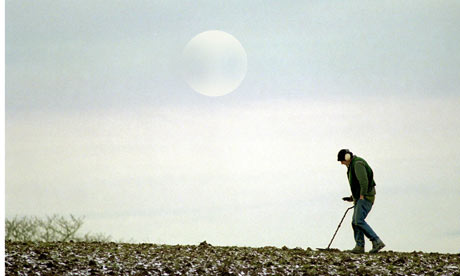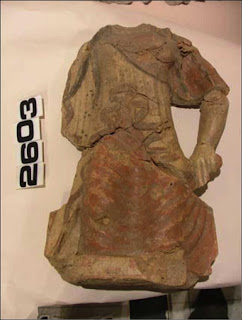Over the summer we were able to take a vacation for 10 days to catch up with some friends in Oaxaca, Mexico; an outstanding city and region with a lot of great culture (particularly food) to offer.
During the trip, we visited the Rufino Tamayo museum in central Oaxaca. It is a museum devoted to indigenous culture, created from Tamayo's personal collection, in an attempt to prevent the illegal trade in antiquities. There are terrific terracotta pieces which depict village life or sporting events. There are also headdresses and other pieces of jewelry. In one of the rooms, the museum states in a variety of languages:
This museum is dedicated to the millenary art which flourished in the area call now-a-days the Republic of Mexico.
Art entirely inspired (with the exception of occidental Mexico) by pre-Columbian religions and myths. It represents the deified forces of nature: the sun, the wind, the water and a multitude of other natural phenomena.
But if in our time the pieces exhibited in the niches of this museum impress its visitors, it is not for religious feelings, because the religions of ancient Mexico a long time ago have been forgotten. Reather, they are moved by the aesthetic rank of the works, their beauty, power and originality.
It is the first time that a Mexican museum exhibits the relics of Indian past in terms of aesthetic phenomena, in terms of works of art.
Each of the rooms of the "Museo del Arte Prehispanico De Mexico Rufino Tamayo" presents—with a certain liberty—objects and sculptures of a specific region and a specific time.
The painter Rufino Tamayo collected these pieces with a great love and artistic sense over more than twenty years, not only for his own pleasure, but also with the purpose of protecting them from exportation and illegal traffac and, first of all, with the wish of donating them to the people of Oaxaca, his native state.


Tamayo left the museum to his native state, to make his countrymen aware of their cultural heritage, and to prevent these objects from being sold abroad. Tamayo was a Zapotec painter born near Oaxaca. He lived in New York from 1926 to 1959. In 1959 he returned to Mexico and soon after created this museum. The museum has a number of stunning works, from all over Mexico. But going through the museum, I was left wondering what the difference between Tamayo and certain other high-profile buyers of antiquities may be. How is Tamayo, and his archaeological museum any different from what
Robin Symes may have done for example? They are different, but there are some troubling similarities as well. I think the one difference is Tamayo acquired these objects and kept them in Mexico, though not necessarily their region. He was preventing the loss of these works of art abroad. But were these objects excavated by archaeologists? The museum visitor is not told.

There's nothing inherently wrong with that I don't think, I mean not every museum needs to focus on the antiquities trade. But certainly there is not a lot of information provided to the museum-visitor. We are told in broad strokes where these objects came from, what culture produced them (Maya, Aztec, Zapotec, etc.) but you don't' get a sense these were objects that were excavated by archaeologists. Rather these are objects which are exhibited for their beauty, to show off the impressive works that were created before Europeans arrived. Displaying these objects sends a powerful message to locals and visitors; just like displaying them in New York or London would send a very different kind of message. In Mexico, they are a symbol of national and indigenous pride. If they were displayed in New York, they might be seen as a cultural appropriation, or even a sign that Mexicans are unable to properly care for their own works of art.
 Mexico
Mexico and its cultural heritage laws have played a vital role in cultural heritage law. I wonder as well if part of the impetus for those laws was supported by efforts like the Tamayo pre-hispanic museum. Mexico has strict export restrictions for art and antiquities, as well as a number of agreements with the US for enforcing those agreements. One of Mexico's first efforts to safeguard its cultural heritage was the enactment in 1916 of the Law on the Conservation of Historical or Artistic Monuments, Buildings, Churches and Objects. In 1972, Mexico—probably in response to the recent UNESCO Convention—enacted the Federal Law on Archaeological, Artistic and Historical Monuments and Sites which defines illicit traffic of cultural patrimony as the import and export of cultural property that is stolen or not given official permission to leave the country. Of course the important McClain prosecutions in the U.S. were a response to the theft of pre-Columbian objects from Mexico.

In the McClain cases (
United States v. McClain, 545 F.2d 988 (5th Cir. 1977);
United States v. McClain, 593 F.2d 658 (5th Cir. 1979) The defendants were convicted under the NSPA for stealing pre-Columbian artefacts from Mexico, and selling them in the United States. This group of art dealers and appraisers created a network in Mexico where artefacts were taken from excavations to the Mexican Archaeological Institute; they were then given false papers and backdated before 1972 in an attempt to give them clean provenance. The objects were then taken across the border to Calexico, California where they were sold. These actions ultimately raised the suspicions of the director of the Mexican Cultural Institute, which informed the FBI, resulting in an undercover investigation.

A Mexican law passed in 1972 nationalized ownership of undiscovered pre-Columbian artefacts. As a result, the provenance and date of discovery of the objects was an important potential issue. However, in the first conviction, the government presented no evidence as to how and when the objects were discovered or exported. The first prosecution, often termed McClain I, dealt with the vesting of ownership of antiquities with Mexico, with the court considering the definition of “stolen” under the National Stolen Property Act in the United States. It determined that the term should be given a broad meaning and remanded to the district court the issue of when precisely the objects were exported from Mexico.

Although the prosecution argued that an 1897 law accomplished state ownership, the court held title did not completely vest with Mexico until enactment of the 1972 law, because only then did Mexico declare ownership of all pre-Columbian artefacts. The jury had not been instructed to determine when any of the pre-Columbian objects at issue had been exported from Mexico, or how to apply the relevant Mexican law to the export. Because of the improper jury instruction, the court remanded the controversy back to the Federal District Court. Although a temporary victory for the defendants, McClain I firmly established the applicability of the NSPA to pieces of cultural property emanating from nations which had vested title to these objects in the state, even where the objects have never been within the physical possession of the foreign government.
On remand, the defendants were once again convicted of violating the NSPA, and of conspiracy to violate the act. At the retrial, the prosecution was required to establish beyond a reasonable doubt that the defendants knew they were selling stolen objects. In McClain II, the court upheld the conspiracy conviction due to overwhelming evidence that the defendants intended to smuggle Mexican artefacts, clearly violating the 1972 Mexican Act, and by implication the NSPA. However, the conviction under the NSPA itself was overturned because of due process concerns. The District Court Judge and not the jury must determine questions of foreign law. As the 5th Circuit Court of Appeals reasoned, the most likely interpretation of the evidence by the jury led to the conclusion that Mexico deemed itself the owner of its pre-Columbian objects as early as 1897. However, that act was too vague to impose criminal liability upon a defendant under the “jurisprudential standards” of the United States.

The conviction of the McClain defendants for conspiracy to violate the NSPA firmly established that individuals may be convicted under the NSPA for dealing in objects that foreign states have nationalized. This ownership interest will be enforced by U.S. courts, despite the absence of any actual possession of the object by the foreign state.
 Range Creek Canyon was an unknown archaeological site to a select few for the last century, but has recently gained a lot of recognition. It has some terrific remnants of the Fremont culture which disappeared about eight centuries ago. The land was owned by Waldo Wilcox who recognized the value of the sites and objects on his land, and kept. He sold the property to the state of Utah in 2001 for $2.5 million.
Range Creek Canyon was an unknown archaeological site to a select few for the last century, but has recently gained a lot of recognition. It has some terrific remnants of the Fremont culture which disappeared about eight centuries ago. The land was owned by Waldo Wilcox who recognized the value of the sites and objects on his land, and kept. He sold the property to the state of Utah in 2001 for $2.5 million. 

























